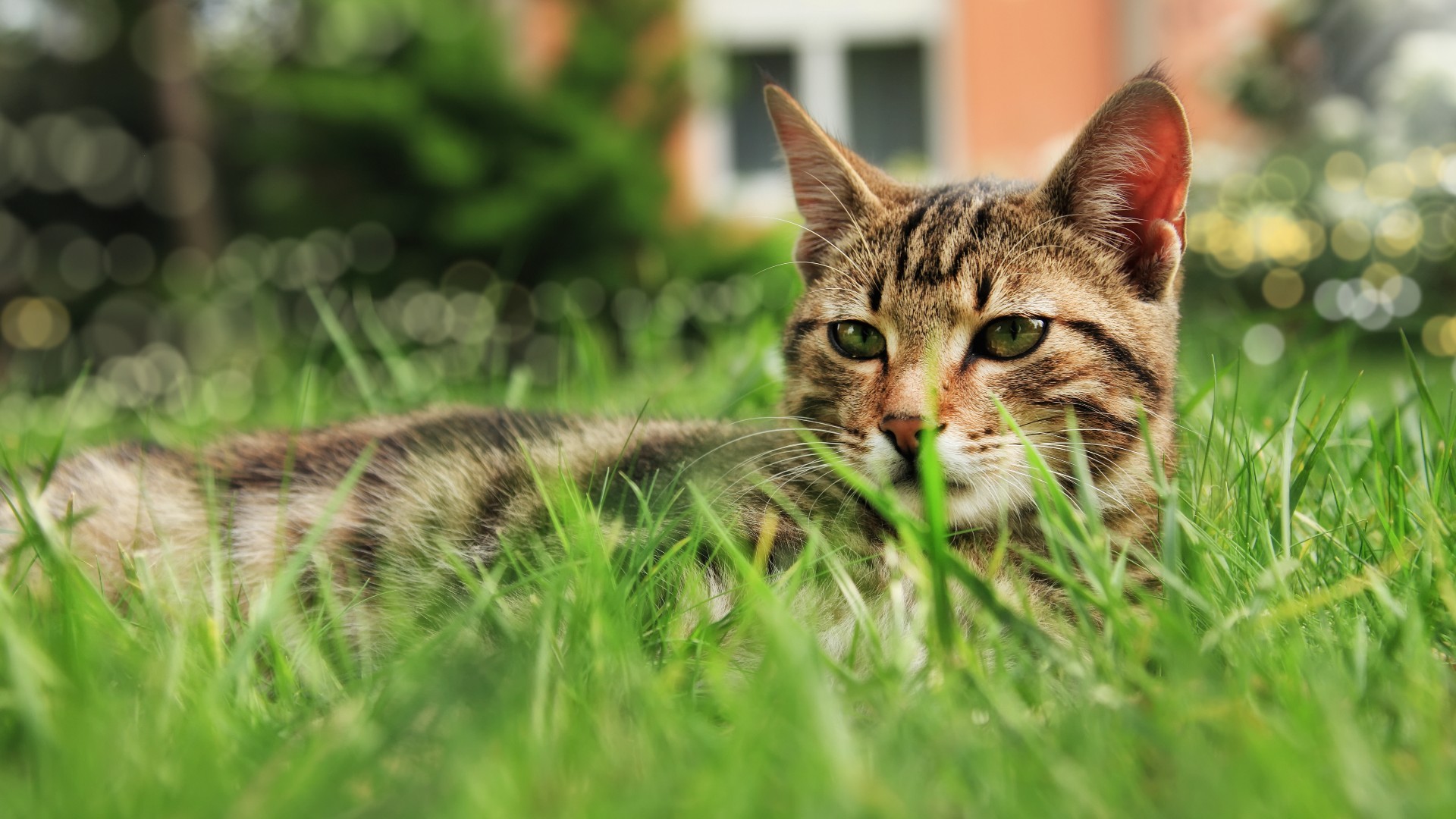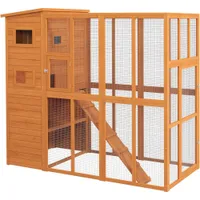How to keep your cat in the yard: 4 tips to keep your kitty safe
Curious as to how to keep your cat in the yard? We spoke to a vet to get their thoughts…

If you’re wondering how to keep your cat in the yard, you’re not alone. While many pet parents like to give their feline friend some freedom to explore nature’s backyard, it always comes with the worry about something happening to them.
And there's a good reason for that. Giving your kitty the feel of the wind on their face and the grass under their paws while safe and secure in one of the best outdoor cat enclosures is one thing, but letting them loose completely is quite another.
While there’s an ongoing debate about indoor vs outdoor cats and which is better for their mental and physical wellbeing, what we do know is that cats who are allowed to venture outside their yard do face increased health risks.
So, with that in mind, is there a way to give your cat access to nature while keeping them safely confined to your yard? We spoke to expert vet Dr. Hannah Godfrey to find out!
Should you let your cat roam free?
As with so many aspects of pet ownership, there isn’t a simple answer to this one and it’s a problem for a lot of people. According to the American Veterinary Medical Association, almost 32 million US households count at least one cat as part of the family.
In fact, the average is 1.8 cats per household, making a grand total of over 58 million. That’s an awful lot of pet cats! In some states there might actually be local government laws prohibiting your cat from free roaming. This is more usual in built up areas, but it’s worth checking what the law is in your area.
"In many countries around the world, it’s uncommon for owned cats to be allowed to roam outside," says Dr. Godfrey. "This may be for cultural reasons, to reduce the impact on local wildlife, to reduce the spread of disease, or to keep cats safe from injuries associated with living in busy, built-up areas. However, in some regions, it’s commonplace for cats to be allowed outdoors. If you do let your cat roam free, they should be neutered, vaccinated, treated for parasites, and microchipped."
Get the best advice, tips and top tech for your beloved Pets
Most experts agree that allowing your cat to be a completely free spirit might pose problems. Cats who roam freely outside tend to have shorter lives than their indoor counterparts. This is because the ‘great outdoors’ is full of dangers, the most obvious being the risk of traffic. Even for rural cats, potential risks lurk round every corner. Outdoor cats are more likely to pick up parasites and diseases, be exposed to weed killers and pesticides or be attacked by predators.
However, allowing your cat access to the outdoors does come with some pretty major benefits. These include the freedom to practise natural behaviors, such as hunting and climbing. Outdoor cats potentially also take a lot more exercise, so they’re less prone to weight problems and are less easily bored.
Caring for outdoor cats can be complex, which is why a great compromise is to let your cat out, but keep her in a safe, enclosed area such as a specially made ‘catio’ or fenced yard. If you do decide to create an enclosed space for your feline friend, check out our guide to charming catio ideas for lots of inspiration and easy to follow instructions.
Before you let your cat out, even if it’s only into your own yard, make sure she’s microchipped with your up-to-date details and is wearing a collar tag. Investing in one of the best GPS trackers for pets can also be well worth it. You should also think about getting your kitty neutered if she's a female – otherwise if she does get out by accident, you might end up with more than you bargained for!
Pawfit 3 GPS Pet Tracker
Want to be able to locate your dog no matter where in the world you might be? Enter the Pawfit 3! With real-time GPS tracking, activity monitoring, a voice command feature for recall and an eight day battery life it gets our seal of approval.
Can you train a cat to stay in your yard?

If you're anything like us, you're always on the hunt for new ways to be the best cat owner and ensure your fur friend stays safe, secure, fit and well. But can you train a cat to stay in your yard?
Well, yes and no. Cats tend to be fiercely independent but they’re also intelligent and quick to pick up new challenges. However, for cat breeds that prefer being outdoors, expecting them not to venture further afield is a big ask. We asked Dr. Godfrey for her thoughts on this, here's what she had to say:
"Some cats are homebodies and would rather stay near home rather than roam from the yard. However, other cats love to explore and will leave the yard at every opportunity. Unfortunately, while you might be able to train your cat to return to you for a treat, which could keep them in the yard, this won’t necessarily work with cats with a really strong instinct to hunt and explore further afield. If your cat loves time outdoors but keeps venturing from your yard, you might want to consider a catio instead."
What can I do to keep my cat in the yard?
The only real surefire way of keeping your cat safe in the great outdoors is to create some kind of boundary which allows them access to nature without complete freedom — like an outdoor cat enclosure or catio.
However, we've chosen to include other options below as well in case you don't have the space for these or would prefer not to confine your kitty in this way.
1. Pet-safe fences
Available from various manufacturers, these fences have inward-sloping sections at the top. Cats generally climb over fences by gripping the top with their claws and rolling over, but younger and more athletic felines simply spring into the air!
Pet safe fences have a section at the top which slopes in at a 45-degree angle so that kitty can’t get a grip. You can either buy these fences as ready-made complete panels, or you can buy just the top section to fit onto an existing fence.
2. Rollertop fences
Rollertop fences are a similar idea, but instead of an inwards-facing panel at the top they have a special roller mechanism which is ungrippable and will deposit your adventuring feline safely back into the yard.
3. Overhead netting
If you don’t want to change your existing fencing, then you could consider fitting an overhead net to stop kitty scaling the walls. This is relatively cheap, but doesn’t look great and is subject to damage from the weather.
4. Outdoor cat enclosures

If you’ve got a large yard, it might be too expensive to cat proof it all the way round. In that case you might like to think about putting up a cat enclosure to allow safe exercise. If you can, it’s ideal to have this built against the house in some way such as around the back door.
This makes it easy to let kitty in and out, or even let her decide for herself where to be in warm weather.
Don’t have too much yard space available? No problem – even an area a few feet square can be transformed into a feline adventure park. Check out these great cat playground ideas for inspiration!
PawHut Large Wooden Outdoor Cat House
Our top pick when it comes to the best outdoor cat enclosure, this full enclosure and playpen has space for multiple cats to explore. The durable but stylish wooden design means it looks great in your garden and while it's one of the more expensive designs on the market, this is definitely a case of getting what you pay for.
We ran all of the above options past Dr. Godfrey and she favors a cat enclosure or catio. Here's why:
"It’s important that any method you choose to keep your cat in the yard is safe and won’t cause them injury," she says. "That’s why netting and fencing can be a bit of a risk – if the holes are large enough for a paw or leg to fit through, they could lead to an injury. Instead, consider constructing a catio for your cat – use cat-safe building materials and keep it well maintained and it will provide a safe and secure spot for your cat to exercise and enjoy the outdoors."
Hopefully our advice has been useful if you’re trying to work out how to keep your cat in the yard. Another option for helping your kitty get fresh air and exercise is to walk her on a harness – it’s a low cost item which doesn’t involve putting fences up, and it can be useful bonding time as well. Check out our guide to the best cat harness for our top picks.
It’s always a balanced act making sure your pet is happy and interested while keeping her safe, but with a little thought you can choose the option that’s right for you.
Want to keep an eye on your kitty when they're in your yard? Check out our guide to the best outdoor wireless cameras for pets and how to set up the perfect catio

Dr Hannah Godfrey studied Veterinary Medicine at the Royal Veterinary College London. After graduating in 2011, Dr Godfrey went on to become a veterinary surgeon, conducting surgery consultations on a range of animals at a small independent practice in Cardiff, South Wales, UK. Dr Godfrey has a strong interest in soft tissue surgery. When she’s not helping animals back on their feet, Dr Godfrey writes a number of veterinary and animal-focused articles.
Sara is a freelance journalist and copywriter of many years’ experience with a lifelong love of animals. She’s written for a range of magazines and websites on subjects varying from pet care to travel. A horse rider since the age of five, she’s currently a full time pet slave to horse Blue and gorgeous, goofy English Springer Spaniel Olly. Adorable Olly has a huge sense of adventure and no sense of direction, keeping Sara on her toes.
- Kathryn WilliamsFreelance writer
- Dr. Hannah Godfrey BVetMed MRCVSVet



